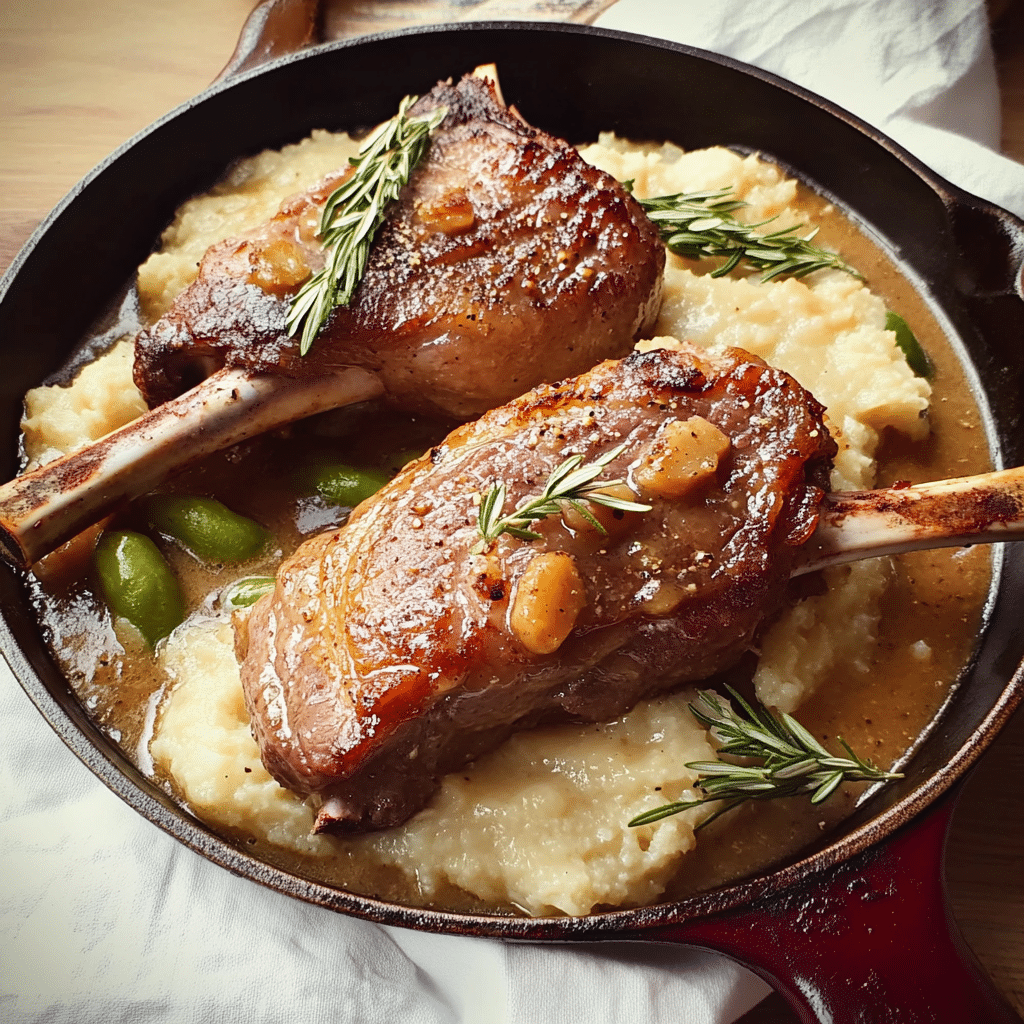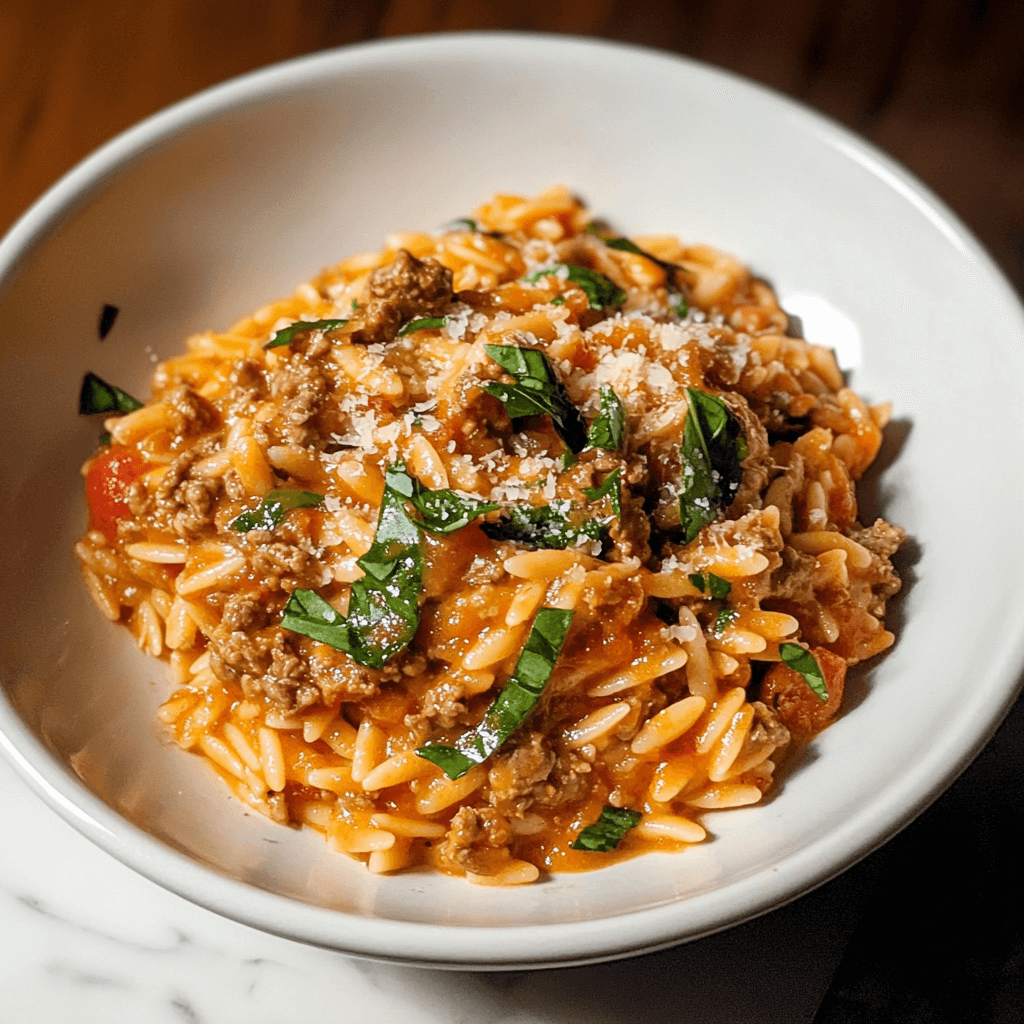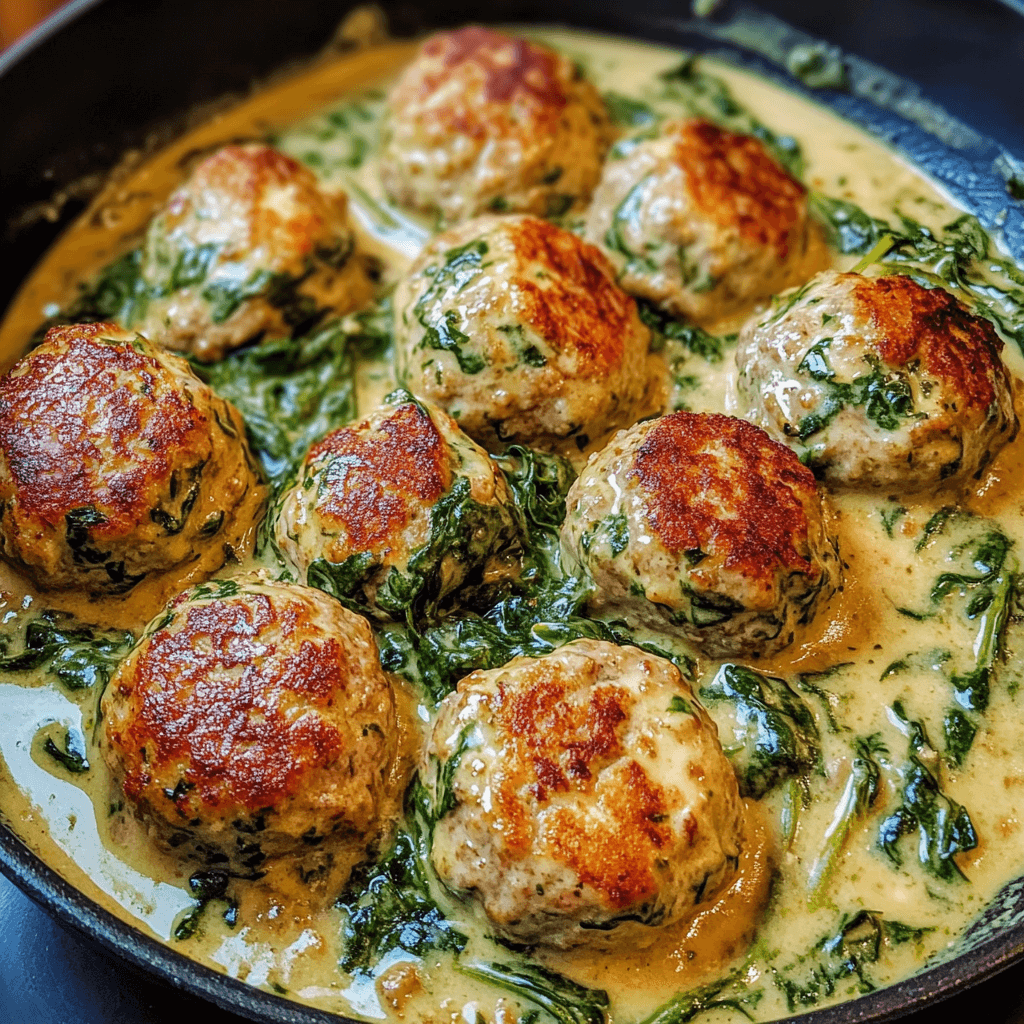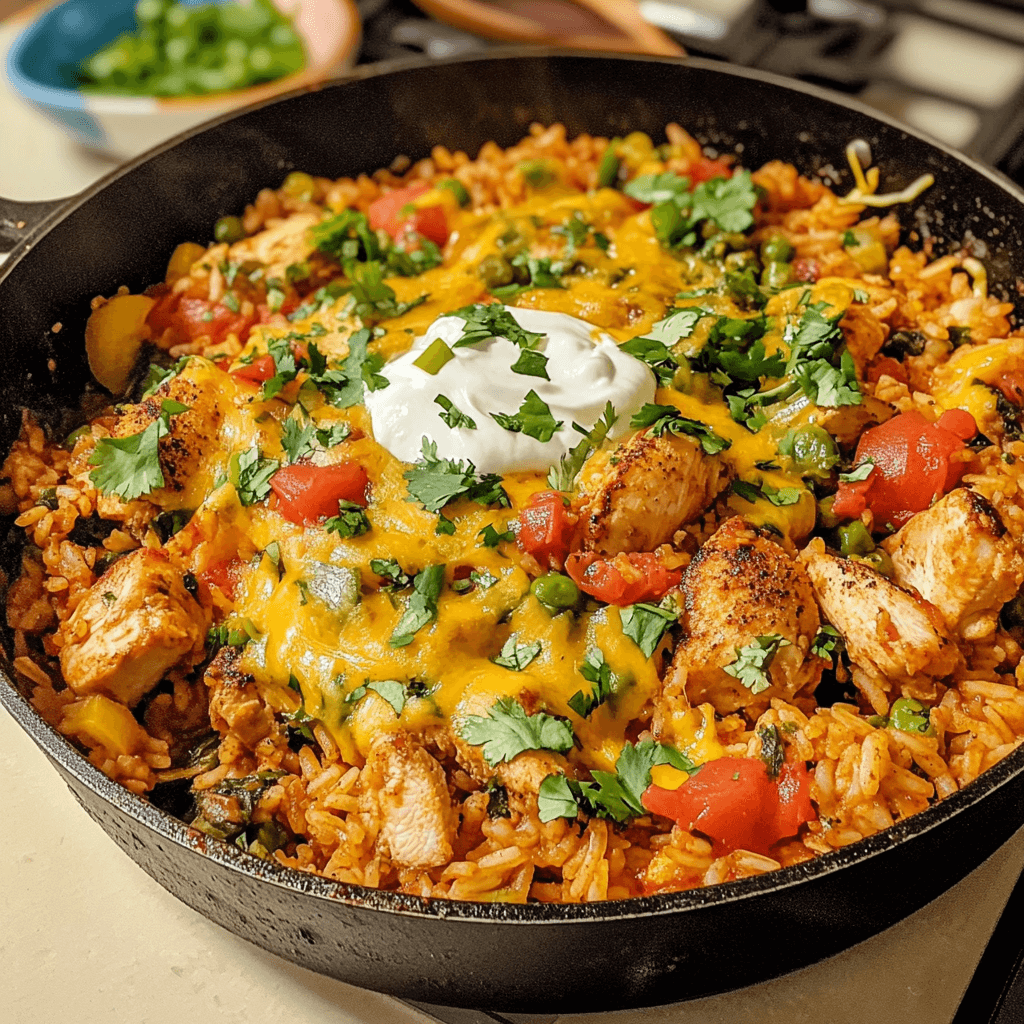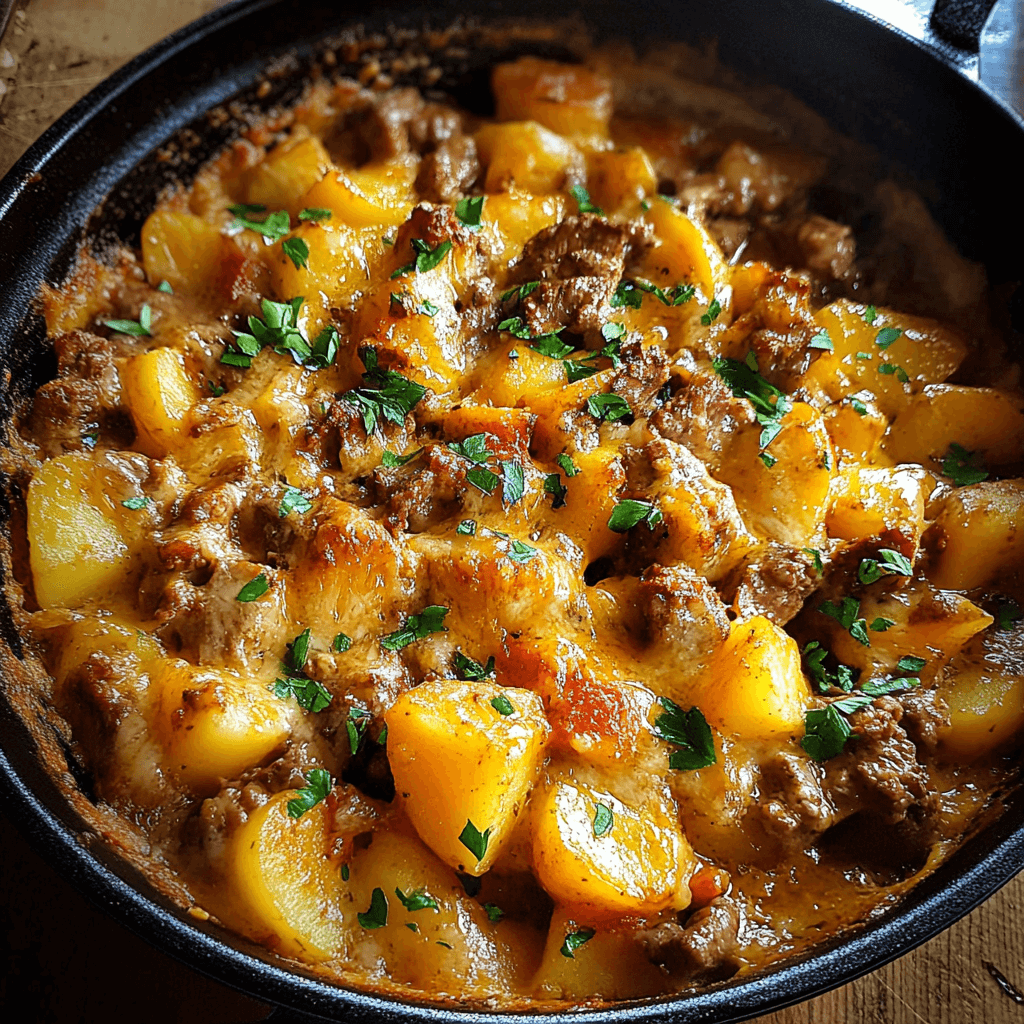Introduction
Imagine the scene: a beautifully roasted prime rib, perfectly seared, resting in a cast-iron skillet, surrounded by fragrant herbs and rich, savory gravy. This Cast-Iron Skillet Prime Rib Roast is not just a meal; it’s an experience that transforms any gathering into a culinary celebration. Whether it’s a holiday feast, a special occasion, or a cozy family dinner, this dish is sure to impress and satisfy.
I first tried this recipe during a family holiday gathering, and it quickly became a cherished tradition. The combination of the juicy, tender meat and the luscious gravy is simply irresistible. Plus, cooking in a cast-iron skillet ensures even heat distribution, creating a beautifully browned crust that seals in the flavor. Let’s delve into why you’ll love this recipe and how to make a show-stopping prime rib roast that your guests will rave about!
Why You’ll Love This Recipe
- Flavorful and Tender: The prime rib roast is known for its rich flavor and tenderness, especially when cooked to perfection.
- Impressive Presentation: A well-cooked prime rib makes for a stunning centerpiece on any dining table, perfect for impressing your guests.
- Simple Cooking Method: Using a cast-iron skillet makes the cooking process straightforward and effective, ensuring even cooking and a delicious crust.
- Savory Gravy: The homemade gravy made from the pan drippings is the perfect accompaniment, enhancing the dish’s flavor.
- Great for Special Occasions: This dish elevates any meal into a special occasion, making it ideal for holidays, celebrations, or simply treating yourself and your loved ones.
Preparation Time and Servings
- Total Time: Approximately 2.5 hours (30 minutes prep, 2 hours cooking)
- Servings: This recipe serves 6-8 people.
- Nutrition Facts: Calories per serving: 600, Protein: 60g, Carbs: 2g, Fat: 40g.
Ingredients
For the Prime Rib Roast
- 1 (4-6 lb) prime rib roast: The star of the dish, known for its rich flavor and tenderness.
- 2 tablespoons olive oil: Helps create a delicious crust and prevents sticking.
- 3 tablespoons kosher salt: Essential for seasoning and enhancing the meat’s natural flavor.
- 2 teaspoons black pepper: Adds a bit of heat and depth to the seasoning.
- 1 tablespoon garlic powder: For an aromatic flavor boost.
- 2 teaspoons fresh rosemary, chopped: Offers a fragrant herbal note.
- 2 teaspoons fresh thyme, chopped: Complements the rosemary and adds freshness.
For the Gravy
- 2 tablespoons all-purpose flour: To thicken the gravy.
- 2 cups beef broth: For a rich, savory base.
- Salt and pepper to taste: Essential for seasoning.
- Optional: Fresh herbs for garnish.
Step-by-Step Instructions
STEP 1: PREHEAT THE OVEN
Start by preheating your oven to 450°F (232°C). This high initial temperature will help develop a beautiful crust on the roast.
STEP 2: PREPARE THE PRIME RIB ROAST
- Bring to Room Temperature: Remove the prime rib from the refrigerator and let it sit at room temperature for about 30 minutes before cooking. This helps it cook more evenly.
- Season the Roast: Pat the roast dry with paper towels. Rub the olive oil all over the meat, then season generously with kosher salt, black pepper, garlic powder, rosemary, and thyme. Ensure the seasoning covers all sides of the roast.
STEP 3: SEAR THE ROAST
- Heat the Skillet: Place your cast-iron skillet over medium-high heat. Allow it to get hot for about 5 minutes.
- Sear the Roast: Carefully place the seasoned prime rib roast in the hot skillet. Sear for about 4-5 minutes on each side, or until a rich brown crust forms. This step locks in the juices and adds depth of flavor.
STEP 4: ROAST IN THE OVEN
- Transfer to Oven: Once seared, transfer the skillet to the preheated oven.
- Initial High Heat: Roast at 450°F (232°C) for 20 minutes to establish a crust.
- Reduce Temperature: After 20 minutes, reduce the oven temperature to 325°F (163°C) and continue roasting for approximately 1.5 hours. Use a meat thermometer to check for doneness; aim for 130°F (54°C) for medium-rare, or 140°F (60°C) for medium.
STEP 5: REST THE ROAST
Once the roast reaches your desired internal temperature, remove it from the oven. Tent it loosely with aluminum foil and let it rest for at least 15-20 minutes. Resting allows the juices to redistribute, ensuring a tender and juicy roast.
STEP 6: MAKE THE GRAVY
- Prepare the Drippings: Place the cast-iron skillet on the stovetop over medium heat. If there’s excess fat, you can drain some off, leaving about 2 tablespoons in the pan.
- Add Flour: Sprinkle the flour into the skillet and whisk it into the drippings, cooking for about 2 minutes to eliminate the raw flour taste.
- Add Broth: Gradually whisk in the beef broth, stirring constantly until the mixture is smooth. Bring to a simmer and cook until thickened, about 5-7 minutes.
- Season: Taste and adjust the seasoning with salt and pepper as needed.
STEP 7: SERVE
- Carve the Roast: Once rested, carve the prime rib into slices against the grain.
- Plate and Garnish: Serve the sliced roast on a platter, drizzled with gravy. Garnish with fresh herbs if desired.
How to Serve
- Classic Sides: Pair your prime rib with traditional sides like garlic mashed potatoes, roasted vegetables, or Yorkshire pudding for a festive meal.
- Salad: A fresh salad, such as a Caesar or mixed greens with vinaigrette, adds a refreshing contrast to the richness of the roast.
- Bread: Serve with crusty bread or dinner rolls to soak up the delicious gravy.
- Wine Pairing: A full-bodied red wine, such as Cabernet Sauvignon or Merlot, pairs beautifully with prime rib, complementing its rich flavors.
Additional Tips
- Choose Quality Meat: Opt for high-quality prime rib for the best flavor and tenderness. Look for well-marbled cuts with a good amount of fat.
- Use a Meat Thermometer: A reliable meat thermometer is essential for achieving your desired doneness without overcooking.
- Don’t Skip the Resting: Resting the meat is crucial for juicy slices. Be patient—this step makes a significant difference.
- Adjust for Cooking Time: Cooking times can vary based on the size and shape of the roast. Always rely on a meat thermometer rather than time alone.
- Save the Bones: If you have leftover bones, consider making a rich beef stock by simmering them with vegetables and herbs for added flavor in future dishes.
Recipe Variations
- Herb-Crusted Prime Rib: Enhance the flavor by creating a herb crust with a blend of fresh herbs, garlic, and breadcrumbs. Apply this mixture after searing for added texture and flavor.
- Garlic Butter Prime Rib: Add a few cloves of crushed garlic and a couple of tablespoons of butter to the skillet during the last few minutes of roasting for a rich garlic flavor.
- Smoked Prime Rib: If you have a smoker, consider smoking the prime rib for a unique flavor profile. This method can impart a delicious smokiness that pairs beautifully with the meat.
- Red Wine Reduction: Instead of using only beef broth for the gravy, deglaze the skillet with red wine before adding the broth for an even richer sauce.
- Stuffed Prime Rib: For an extravagant twist, consider stuffing the prime rib with a mixture of herbs, cheese, and breadcrumbs before roasting.
Side Dish Pairings
When serving a prime rib roast, the right sides can elevate the meal. Here are some excellent options to complement your main dish:
1. Garlic Mashed Potatoes
Creamy garlic mashed potatoes are a staple side that pairs perfectly with prime rib. The smooth texture and buttery flavor make them irresistible.
2. Roasted Brussels Sprouts
Crispy roasted Brussels sprouts with a sprinkle of salt and pepper offer a delicious contrast to the richness of the roast.
3. Creamed Spinach
A rich and creamy spinach dish brings a touch of elegance to your plate and balances the savory meat.
4. Yorkshire Pudding
This classic British side is a must-have with prime rib. Made from a simple batter, they are baked until puffed and golden, perfect for soaking up gravy.
5. Caramelized Carrots
Sweet and tender caramelized carrots add a touch of sweetness and color to your meal, enhancing the overall presentation.
Freezing and Storage
Leftover prime rib can be just as delicious the next day! Here’s how to store and reheat it properly:
Storage
- Refrigeration: Allow the prime rib to cool completely before slicing. Store in an airtight container in the refrigerator for up to 3 days.
Freezing
- Freezing: For longer storage, wrap the leftover prime rib tightly in plastic wrap and then in aluminum foil. It can be frozen for up to 3 months.
Reheating
- Thaw: If frozen, thaw the prime rib in the refrigerator overnight.
- Reheat: To reheat, place the slices in a baking dish with a splash of beef broth to prevent drying out. Cover with foil and heat in a preheated oven at 325°F (163°C) for about 20-30 minutes, or until warmed through.
FAQ Section
Can I use a different cut of beef?
Yes, you can use other cuts like ribeye or sirloin, but adjust cooking times based on the thickness and size of the meat.
What should I do if I can’t find prime rib?
Look for a standing rib roast, which is the same cut of meat. If unavailable, a well-marbled beef roast can work as a substitute.
Can I make gravy without drippings?
Yes! You can use beef broth and flour, seasoning to taste, but the drippings provide a depth of flavor that enhances the gravy.
How long does it take to cook prime rib per pound?
As a general rule, cook at 325°F (163°C) for about 15-20 minutes per pound for medium-rare.
What should I do with leftover gravy?
Leftover gravy can be stored in the fridge for up to a week or frozen for later use. Reheat gently on the stovetop before serving.
Conclusion
I hope you’re excited to try this Cast-Iron Skillet Prime Rib Roast and Gravy! It’s a dish that brings warmth and flavor to your table, making every bite a delightful experience. Whether for a holiday celebration or a weeknight dinner, this recipe is sure to impress.
Don’t forget to share your results! I can’t wait to see how your prime rib turns out—be sure to leave a comment or tag me on social media with your delicious creations. Enjoy your cooking adventure, and may your kitchen be filled with the wonderful aroma of roasted prime rib!
Gather your loved ones, serve up this delicious prime rib roast, and create lasting memories around the dinner table!
Print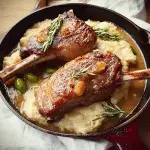
Cast-Iron Skillet Prime Rib Roast and Gravy: The Ultimate Feast
- Total Time: 2.5 hours
Description
Experience the ultimate in indulgent dining with this Cast-Iron Skillet Prime Rib Roast and Gravy. This recipe showcases a succulent prime rib, perfectly seared for a rich, flavorful crust and slow-roasted to tender perfection. Cooked in a cast-iron skillet, the roast absorbs the heat evenly, ensuring every bite is juicy and packed with flavor. The accompanying homemade gravy, made from savory pan drippings, elevates the dish even further, making it a perfect centerpiece for special occasions or holiday gatherings. Whether you’re celebrating with family or impressing guests, this prime rib roast promises to be a show-stopping feast that will leave everyone craving more.
Ingredients
For the Prime Rib Roast
- 1 (4-6 lb) prime rib roast: The star of the dish, known for its rich flavor and tenderness.
- 2 tablespoons olive oil: Helps create a delicious crust and prevents sticking.
- 3 tablespoons kosher salt: Essential for seasoning and enhancing the meat’s natural flavor.
- 2 teaspoons black pepper: Adds a bit of heat and depth to the seasoning.
- 1 tablespoon garlic powder: For an aromatic flavor boost.
- 2 teaspoons fresh rosemary, chopped: Offers a fragrant herbal note.
- 2 teaspoons fresh thyme, chopped: Complements the rosemary and adds freshness.
For the Gravy
- 2 tablespoons all-purpose flour: To thicken the gravy.
- 2 cups beef broth: For a rich, savory base.
- Salt and pepper to taste: Essential for seasoning.
- Optional: Fresh herbs for garnish.
Instructions
STEP 1: PREHEAT THE OVEN
Start by preheating your oven to 450°F (232°C). This high initial temperature will help develop a beautiful crust on the roast.
STEP 2: PREPARE THE PRIME RIB ROAST
- Bring to Room Temperature: Remove the prime rib from the refrigerator and let it sit at room temperature for about 30 minutes before cooking. This helps it cook more evenly.
- Season the Roast: Pat the roast dry with paper towels. Rub the olive oil all over the meat, then season generously with kosher salt, black pepper, garlic powder, rosemary, and thyme. Ensure the seasoning covers all sides of the roast.
STEP 3: SEAR THE ROAST
- Heat the Skillet: Place your cast-iron skillet over medium-high heat. Allow it to get hot for about 5 minutes.
- Sear the Roast: Carefully place the seasoned prime rib roast in the hot skillet. Sear for about 4-5 minutes on each side, or until a rich brown crust forms. This step locks in the juices and adds depth of flavor.
STEP 4: ROAST IN THE OVEN
- Transfer to Oven: Once seared, transfer the skillet to the preheated oven.
- Initial High Heat: Roast at 450°F (232°C) for 20 minutes to establish a crust.
- Reduce Temperature: After 20 minutes, reduce the oven temperature to 325°F (163°C) and continue roasting for approximately 1.5 hours. Use a meat thermometer to check for doneness; aim for 130°F (54°C) for medium-rare, or 140°F (60°C) for medium.
STEP 5: REST THE ROAST
Once the roast reaches your desired internal temperature, remove it from the oven. Tent it loosely with aluminum foil and let it rest for at least 15-20 minutes. Resting allows the juices to redistribute, ensuring a tender and juicy roast.
STEP 6: MAKE THE GRAVY
- Prepare the Drippings: Place the cast-iron skillet on the stovetop over medium heat. If there’s excess fat, you can drain some off, leaving about 2 tablespoons in the pan.
- Add Flour: Sprinkle the flour into the skillet and whisk it into the drippings, cooking for about 2 minutes to eliminate the raw flour taste.
- Add Broth: Gradually whisk in the beef broth, stirring constantly until the mixture is smooth. Bring to a simmer and cook until thickened, about 5-7 minutes.
- Season: Taste and adjust the seasoning with salt and pepper as needed.
STEP 7: SERVE
- Carve the Roast: Once rested, carve the prime rib into slices against the grain.
- Plate and Garnish: Serve the sliced roast on a platter, drizzled with gravy. Garnish with fresh herbs if desired.
- Prep Time: 30 minutes
- Cook Time: 2 hours
Nutrition
- Calories: 600 kcal
- Fat: 40g
- Carbohydrates: 2g
- Protein: 60g

